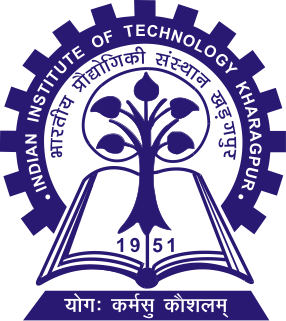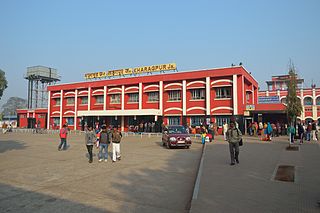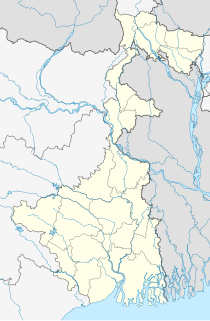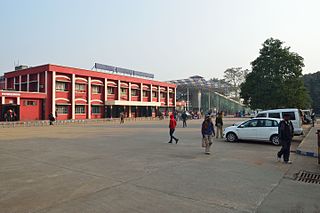
Indian Institute of Technology Bombay is a public technical and research university located in Powai in Mumbai, Maharashtra, India.

Indian Institute of Technology Kharagpur is a public technical and research university established by the government of India in Kharagpur, West Bengal, India. Established in 1951, the institute is the first of the IITs to be established and is recognised as an Institute of National Importance. In 2019 it was awarded the status of Institute of Eminence by the government of India.

Hijli Detention Camp, is a former detention camp operated during the period of British colonial rule in India. Located in Hijli, beside Kharagpur, in the district of Midnapore West, West Bengal, India, it played a significant role in the Indian independence movement of the 19th and 20th centuries.

Kharagpurpronunciation (help·info) is an industrial city in Paschim Medinipur district of West Bengal, India. It is the headquarters of the Kharagpur subdivision. It is the most populated, multicultural and cosmopolitan city of the district. The first Indian Institute of Technology, one of the Institutes of National Importance, was founded in Kharagpur in May 1950. It has one of the largest railway workshops in India, and the third longest railway platform in the world.

Hijli is a neighborhood of Kharagpur in the Kharagpur subdivision of the Paschim Medinipur district in the state of West Bengal, India.

Motilal Nehru National Institute of Technology Allahabad, formerly Motilal Nehru Regional Engineering College (MNREC), is a public technical university located in Allahabad (Prayagraj), Uttar Pradesh, India. It is one among the top NITs in the country, and like the rest of them, classified as an Institute of National Importance. The college has the distinction of being the first in the country to start an undergraduate programme in Computer Science & Engineering, in 1976-77.

Rajiv Gandhi School of Intellectual Property Law (RGSOIPL) is a law school based at the Indian Institute of Technology, Kharagpur. It was set up in collaboration with the George Washington University Law School, Washington DC and is the only law school within the IIT system. It is also the first law school in India imparting full-time Intellectual Property education along with other regular courses prescribed by the Bar Council of India.
The Indian Institutes of Technology (IITs) are the premier autonomous public technical and research universities located across India.
The Joint Entrance Examination (JEE) is an engineering entrance assessment conducted for admission to various engineering colleges in India. It is constituted by two different examinations: the JEE Main and the JEE Advanced.
The Hijli Kingdom existed between 1687 and 1886 in the eastern part of India. Initially Hijli was a small island village on the banks of the Rasulpur River as it flows to the Bay of Bengal. It developed into a port town in 1687. Slowly, it converted into a province or kingdom covering parts of Bengal and Orissa. The Contai basin also belonged to this kingdom. Mansingh is believed to be the founder King of Hijli. It had important towns like Tamluk or Tamralipta, Panskura, along with Keleghai and Haldi rivers on the north, the south and east sides bounded by the Bay of Bengal and Kharagpur, Keshiary, Dantan and Jaleswar on the west. The capital of Hijli was in Bahiri up to 1628 and afterwards it was shifted to Hijli. This kingdom was ruled for some years by Taj Khan, a disciple of Guru Peer Mackdram Sha Chisti. It was also ruled sequentially by Kushan, Gupta and Pal dynasties and also by Mughals. It is known that Hijli had excellent business and trade centers during the reign of Hindu Kings and continued during the Mughal dynasty.

Nehru Science Centre (NSC) is the largest interactive science centre in India. It is located in Worli, Mumbai. The centre is named after India's first Prime Minister, Jawaharlal Nehru. In 1977, the centre started with the 'Light and Sight' exhibition, and then in 1979 a Science Park was built. On 11 November 1985 it was opened to the public by Rajiv Gandhi, the then Prime Minister of India.

The School of Medical Science and Technology (SMST) is an educational and research institute affiliated to the Indian Institute of Technology, Kharagpur, India. Founded in 2001 the School of Medical Science and Technology brings together doctors, scientists and engineers to work collaboratively on projects for better healthcare.

Indian Institute of Technology Bhubaneswar is a public technical and research university established by the government of India in 2008, located at Bhubaneswar, Odisha, India. It is one of the eight new Indian Institutes of Technology (IITs) established by the Ministry of Human Resource Development, Government of India under The Institutes of Technology (Amendment) Act, 2011 which establishes the eight new IITs as well as declares IT-BHU as Indian Institute of Technology. The Act was passed in the Lok Sabha on 24 March 2011 and by the Rajya Sabha on 30 April 2012. It started functioning from the campus of IIT Kharagpur on 23 July 2008 and shifted its operation to the city of Bhubaneswar on 22 July 2009.

Kharagpur subdivision is an administrative subdivision of Paschim Medinipur district in the state of West Bengal, India.

The Indian Institutes of Technology (IITs) are autonomous public technical universities located across India. They are governed by the Institutes of Technology Act, 1961, which has declared them as Institutes of National Importance and lays down their powers, duties, and framework for governance. The Institutes of Technology Act, 1961 lists twenty-three institutes. Each IIT is autonomous, linked to the others through a common council, which oversees their administration. The Minister of Education is the ex officio Chairperson of the IIT Council. As of 2020, the total number of seats for undergraduate programs in all IITs is 16,053.

Kharagpur Junction railway station is a railway station in Kharagpur subdivision of Paschim Medinipur district in the Indian state of West Bengal. It is also the third longest railway station by platform length after Gorakhpur Junction railway station and Kollam Junction railway station.
India has the largest numbers of engineers as well as the largest number of engineering education institutes and infrastructure in the world. In 2021, India annually produces one million engineering graduates, has 3500 engineering colleges, 3400 polytechnics, and 200 schools of planning and architecture, and many times more Industrial training institute. Combination of these impart undergraduate and graduate courses in architecture, engineering, applied engineering and sciences.

Bhrigu Nath Singh, also known as B.N. Singh, is an Indian engineering scientist. He is a distinguished professor and Institute's first Dean of Human Resources, Indian Institute of Technology Kharagpur. Chair of the ICTACEM and former Head of Department Aerospace Engineering, IIT Kharagpur.

Santosh kumar Mitra or Santosh Mitra was an activist of the Indian independence movement and a martyr.

Tarakeshwar Sengupta was an Indian independence activist who took part in the Chittagong Armoury Raid. He was a member of revolutionary group of Masterda Surya Sen.
















